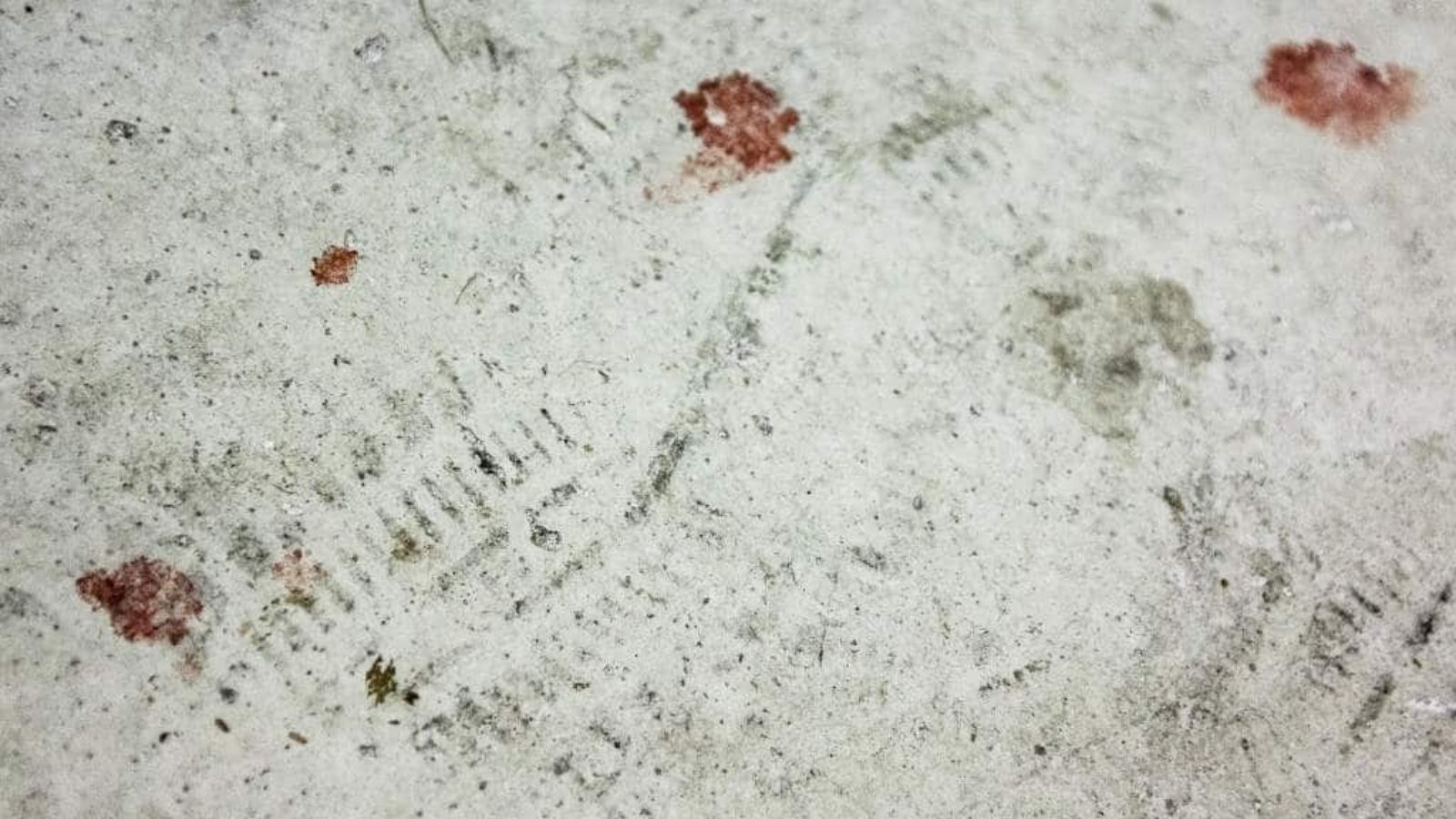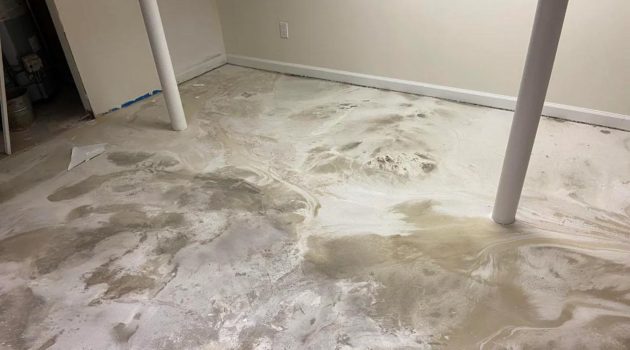Removing blood stains from concrete can be challenging due to the porous nature of the material.
Concrete’s rough and absorbent surface means that liquids, like blood, can seep deep into the pores, making complete stain removal tough.
However, with the right approach and materials, you can effectively clean your concrete floor and eliminate unsightly blood stains.
If you’ve encountered a blood stain on your concrete floor, it’s important to address it as quickly as possible. Fresh stains are always easier to clean than those that have had time to set in.
There are several methods you can employ, from household items like hydrogen peroxide to commercial cleaners designed for concrete. Knowing how to tackle the stain without damaging the concrete is key.
Safety is paramount when dealing with blood stains, especially if the origin of the blood is unknown.
Before you start the cleaning process, make sure to don protective gloves and, if necessary, other protective gear like safety glasses and a mask.
This will protect you from any potential pathogens in the blood and from the cleaning agents used to remove the stain.
1. Safety First
When dealing with blood stains on concrete, your safety is paramount. Blood can carry pathogens, such as Hepatitis B, Hepatitis C, and HIV, which can be hazardous to your health.
Protecting yourself from potential infection is a crucial first step.
- Protective Gloves: Always wear chemical protective gloves to prevent any direct contact with blood. The gloves should be durable and puncture-resistant.
- Safety Goggles: Protect your eyes from splashes by wearing safety goggles. Ensure they fit snugly over and around your eyes without any gaps.
- Protective Clothing: It’s advisable to wear clothing that covers your skin, reducing the risk of exposure to harmful substances. Consider long-sleeved shirts and long pants.
- Mouth Mask: A mouth mask can prevent accidental inhalation of any airborne particles from the cleaning agents or the blood stain itself.
Before starting the cleaning process, ensure you have all these safety items on.
Once you have these safety measures in place, you can proceed to clean the blood stain confidently, knowing you’ve taken the right steps to protect yourself.
Remember to dispose of these protective items properly after use to prevent any accidental spread of disease.
2. Initial Cleaning
When tackling blood stains on concrete, acting quickly and carefully is crucial.
The porosity of concrete can make blood stains challenging to remove, so immediate attention can greatly improve your chances of success in the cleaning process.
Remove Excess Blood
To start, you need to gently remove any excess blood. If the blood is still fresh, take a paper towel or a clean cloth and gently dab at the stain to soak up as much blood as possible.
Avoid rubbing the area as this can push the blood deeper into the porous concrete.
Materials Needed: Paper towels or a clean cloth.
Method:
- Dab gently on the blood to absorb the excess fluid.
- If there are solidified components, use a broom or a brush to sweep up the debris.
Pre-Cleaning the Surface
Once the excess blood is removed, prepping the surface is the next step. Rinse the area with cold water; hot water can set the stain, making it more difficult to clean.
A stiff-bristled brush can help loosen any blood that has started to seep into the concrete. A sponge can be used for a more gentle approach if needed.
Materials Needed: Stiff-bristled brush, sponge, water.
Steps:
- Rinse the area with cold water to help dilute the blood.
- Use a stiff-bristled brush to lightly scrub the surface.
- Repeat if necessary to ensure the area is prepared for deeper cleaning.
3. Stain Removal Techniques
Removing blood stains from a concrete floor can be challenging, but with the right techniques, you can restore your concrete to its original state.
You have two main options: chemical methods, which are highly effective for stubborn stains, and natural alternatives, which are better for the environment and your health.
Chemical Methods
When dealing with tough blood stains on concrete, chemical cleaners can be a powerful choice.
- Hydrogen Peroxide: This is a mild bleach that can break down blood without harming the concrete. Apply it directly to the stain and allow it to foam as it reacts with the blood. After it stops foaming, scrub the area with a stiff brush and rinse with water.
- Sodium Peroxide: A stronger option that should be used with caution. Sprinkle the powder on the stain, let it sit to break down the proteins in the blood, and then scrub off. Always wear protective gloves and a mask when handling these substances.
- Commercial Bleach: If the blood stain is fresh, bleach can be highly effective. Scrub it into the stain and let sit before rinsing. However, bleach is toxic and should be used in a ventilated area, with protective clothing.
| Chemical | Application Method | Safety Precautions |
|---|---|---|
| Hydrogen Peroxide | Apply directly, let it react, then scrub and rinse | Minimal; safe for most users |
| Sodium Peroxide | Sprinkle, allow to sit, then scrub off | Gloves and mask recommended |
| Bleach | Apply and scrub into stain, let sit, then rinse | Good ventilation and protective clothing needed |
Natural Alternatives
If you prefer avoiding harsh chemicals, there are natural solutions that can also be effective.
- Vinegar: Vinegar is a mild acid that can dissolve the blood. Pour it over the stain, let it soak in, and then scrub vigorously with a brush. Rinse well with water afterwards.
- Baking Soda and Lemon Juice: For a scrubbing paste, mix baking soda with lemon juice. Apply the mixture to the stain, leave it for a few minutes to penetrate, and scrub away with a brush. This combo can lessen the visibility of the stain significantly.
- Detergent: Mixing liquid dish detergent with water can create a soap solution that’s useful for milder stains. Apply with a brush, scrub, and then rinse off with water for an effective clean.
Remember to test a small, inconspicuous area first with any method you choose to ensure it won’t damage your concrete.
4. Final Cleaning and Prevention
After you’ve managed to scrub the stain thoroughly, the next step is to rinse the area to wash away any remaining cleaning agents.
Saturate the area with clear, cold water—a spray bottle could be handy for this. Be generous but controlled with the water; you want to avoid creating a new mess to deal with.
Once the rinsing is done, allow the concrete to air dry thoroughly. This may take some time, depending on weather and indoor conditions.
If you are indoors and the stain was in an area difficult to ventilate, consider using a fan to speed up the drying process.
As you wait for the area to dry, it’s an excellent moment to think about prevention. To prevent similar incidents, especially in areas prone to accidents, you might consider placing rugs or mats.
These not only add a touch of décor but also protect the concrete underneath from stains.
For items like furniture or carpets that might sometimes have contact with concrete, ensure they’re treated with a stain repellent if possible.
To maintain a clean floor, routine cleaning is essential. Regularly mop the concrete areas with appropriate floor cleaners to lessen the likelihood of stains setting.
Plus, the quicker you can clean up any future spills, the easier they’ll be to manage.
Remember, porous surfaces like concrete hold onto stains stubbornly, so responding promptly to accidents is your best strategy for keeping it looking great.



